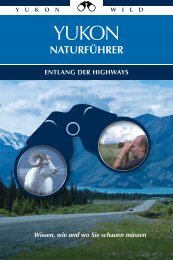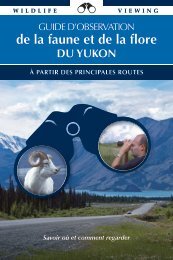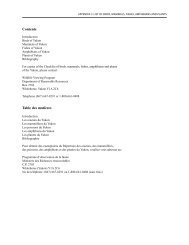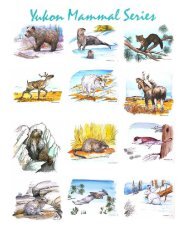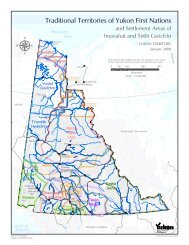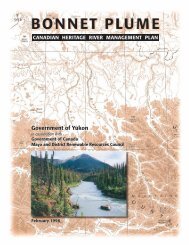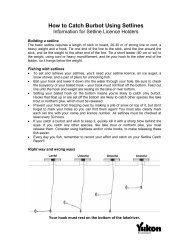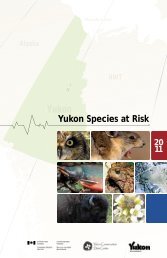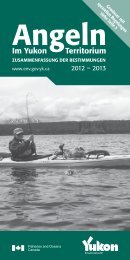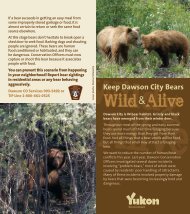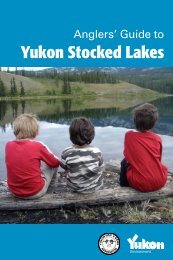Ch. 3 Land - Environment Yukon
Ch. 3 Land - Environment Yukon
Ch. 3 Land - Environment Yukon
Create successful ePaper yourself
Turn your PDF publications into a flip-book with our unique Google optimized e-Paper software.
Figure 3.12 shows the location of some<br />
of the active mines, development<br />
projects and exploration projects in the<br />
<strong>Yukon</strong> in 1998. Production occurred<br />
at Brewery Creek and Mount Nansen<br />
in 1998. During 1999, only Brewery<br />
Creek Mine operated.<br />
Placer Mining<br />
Placer deposits occur throughout the<br />
<strong>Yukon</strong>, though historically, most of the<br />
mining has taken place in the Klondike<br />
gold fields near Dawson City. This area<br />
is particularly favourable for placer<br />
Early Placer Miners<br />
The first placer miners in the<br />
<strong>Yukon</strong> were First Nation people<br />
who recovered native copper<br />
nuggets from the White River area<br />
in the southwestern part of the<br />
<strong>Yukon</strong> Territory. After 1850,<br />
prospectors and explorers began<br />
to report fine gold on river bars<br />
and coarse gold in the Fortymile<br />
and Sixtymile rivers. On August<br />
17, 1896, the discovery of nugget<br />
gold by George Carmack and<br />
Skookum Jim on Bonanza Creek<br />
set off the Klondike gold rush.<br />
Emeralds<br />
In 1999, Expatriate Resources<br />
announced that emeralds had<br />
been discovered on one of its<br />
exploration properties near<br />
Finlayson Lake. The company has<br />
commissioned a team of gem<br />
experts to evaluate the find. Gem<br />
quality emeralds are extremely<br />
rare and much work is needed to<br />
recover and appraise the rough<br />
gems. The wintering range of the<br />
Finlayson Woodland Caribou herd<br />
is located in this area.<br />
deposits because it lies in the<br />
unglaciated part of the <strong>Yukon</strong>.<br />
Approximately 80 per cent of the<br />
<strong>Yukon</strong>’s placer gold is currently mined<br />
from the Klondike and other<br />
unglaciated parts of the territory.<br />
Placer deposits consist of loose material<br />
(gravel, sand and clay) formed by the<br />
weathering of mineralized bedrock. As<br />
the bedrock breaks down, heavy<br />
minerals like gold, silver, platinum, tin,<br />
copper, tungsten and some gemstones<br />
are released. These minerals<br />
concentrate in layers because their<br />
relative weight (specific gravity) allows<br />
gravity and the natural flow of water<br />
to sink them to the bottom of creeks<br />
or a ‘hardpan’ layer where they<br />
accumulate through time.<br />
Water is usually used as the<br />
transporting or washing agent to<br />
remove gold from sand and gravel.<br />
Minto<br />
Mt. Nansen<br />
Brewery Creek<br />
Dublin Gulch<br />
Carmacks Copper<br />
The water is often pumped from a<br />
stream into an elaborate system of<br />
pumps and settling ponds and is later<br />
returned once the fine sediments have<br />
settled. Water quality standards for<br />
<strong>Yukon</strong> placer mining streams are set<br />
by the <strong>Yukon</strong> Placer Authorization<br />
which establishes the allowable<br />
sediment that may be discharged into<br />
streams, based on fish habitat.<br />
Low gold prices continued to daunt<br />
the <strong>Yukon</strong>’s placer industry in 1998<br />
and 1999, resulting in a decrease in<br />
both production and employment;<br />
however, placer mining is still an<br />
important sector in the <strong>Yukon</strong>’s<br />
economy. In 1998, 90,288 ounces of<br />
placer gold, valued at $31 million (Cdn),<br />
were produced from 161 placer mines<br />
employing approximately 600 people.<br />
This represents an approximate 22 per<br />
cent drop in production from 1997.<br />
4 6 ❧ Y U K O N S T A T E O F T H E E N V I R O N M E N T R E P O R T 1999<br />
Keno Hill<br />
Faro<br />
Marlin<br />
Tea<br />
Kudz Ze<br />
Kayah<br />
Active Mines<br />
Past Producing and Developing<br />
Hardrock Mines<br />
Exploration Projects<br />
Tintina Trench<br />
Sa Dena Hes<br />
100 Km<br />
Figure 3.12 1998 <strong>Yukon</strong> Mining, Development and Exploration<br />
By 1999, Brewery Creek was the only active mine operating in the <strong>Yukon</strong>.





